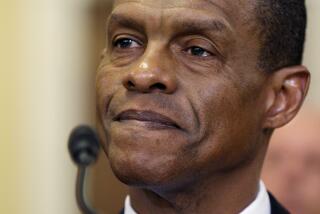Editorial: The right way and the wrong way on law enforcement drones
The Los Angeles Police Department’s slow and careful process for developing a policy on how it will deploy drones is imperfect, but Chief Charlie Beck and his department are approaching the question in the proper spirit, taking public input and considering the many very serious concerns about drones being used for unwarranted police snooping.
If only L.A. County Sheriff Jim McDonnell would take heed.
Both the LAPD and the Sheriff’s Department have already acquired the small, remote-controlled and camera-equipped devices that could prove valuable in providing an aerial view of tense standoffs — or could just as easily be misused to ramp up intrusive public surveillance, ostensibly in the name of crime prevention. McDonnell unveiled his program in January as a done deal and has deployed one drone despite criticism from members of the Sheriff Civilian Oversight Commission, who want publicly vetted standards for using the equipment.
Beck, by contrast, has sworn off drone flights pending the drafting of guidelines and a series of public meetings, and amid demonstrations by activists who oppose any use of the devices in their belief — not altogether unreasonable, given how some departments have used red-light cameras and license-plate readers — that once police have them they will be prone to misuse them. The LAPD presented its drone proposal to the civilian Police Commission on Tuesday and reiterated that the drones won’t fly until that panel signs off on deployment guidelines that have yet to be drafted.
The LAPD could improve its drone process by making its proposed guidelines public before asking for input, then revising them as appropriate.
That process is important. It demonstrates that the Police Department understands public concern over new technologies and their penchant to erode privacy, especially when wielded by armed government officers with powers to arrest, and by a department with a history of compiling dossiers not merely on criminal suspects but on political enemies and individuals holding controversial opinions. The process also underscores the LAPD’s relationship with its civilian overseers on the commission, which at least in name are collectively in charge of the department and dictate its policy.
The Police Commission has already sought public input on the use of a different recording technology: body cameras, which were once widely embraced by police critics as a tool to provide an unbiased view of shootings, arrests or other police encounters. In a cautionary note for the LAPD’s drone ambitions, many supporters of body cameras now reject them on the argument that police exercise too much control over the video before the public sees it.
Tools are just tools, whether they are body cameras, drones or flashlights, and are intrinsically neither good nor bad without carefully crafted, publicly reviewed and strictly enforced rules for using them. Such rules should be subject to periodic review, as should each use of a drone. The benefits of the technology should be weighed against not just the monetary costs but the potential for impingement on civil liberties, and the burden should fall on law enforcement to make the case for deploying it.
Without such rules and processes, even older tools are subject to abuse, as was the case more than a decade ago when LAPD officers improperly used their heavy flashlights as batons. Much time was spent over replacement flashlight models, but the process was important and won back a measure of the community support that the department had lost after more and more cases surfaced of officers beating suspects with their old-style flashlights.
The LAPD could improve its drone process by making its proposed guidelines public before asking for input, then revising them as appropriate, as many times as necessary. Without that step, public meetings become a sort of suggestion box — not without value, but not as useful as they could be.
Like Beck’s department, McDonnell’s has an oversight panel — but unlike the Police Commission, it is less than a year old, has no enforcement powers and is still figuring out its role. McDonnell launched a one-year drone pilot project without waiting for commission input. The law entitled him to do that. Good judgment and political acumen, however, would have dictated a different course.
Last month, after testimony and public input, a majority of the sheriff’s oversight commissioners called for grounding McDonnell’s drone pending further review and input. The department has relied on a survey showing public support for drone use, but such surveys don’t generally outline the pluses and minuses of any new technology and are no substitute for careful vetting by an oversight body of deployment guidelines. McDonnell would be wise to follow the LAPD’s lead in grounding his drone pending a process that invites meaningful public input and oversight.
Follow the Opinion section on Twitter @latimesopinion and Facebook
More to Read
A cure for the common opinion
Get thought-provoking perspectives with our weekly newsletter.
You may occasionally receive promotional content from the Los Angeles Times.






